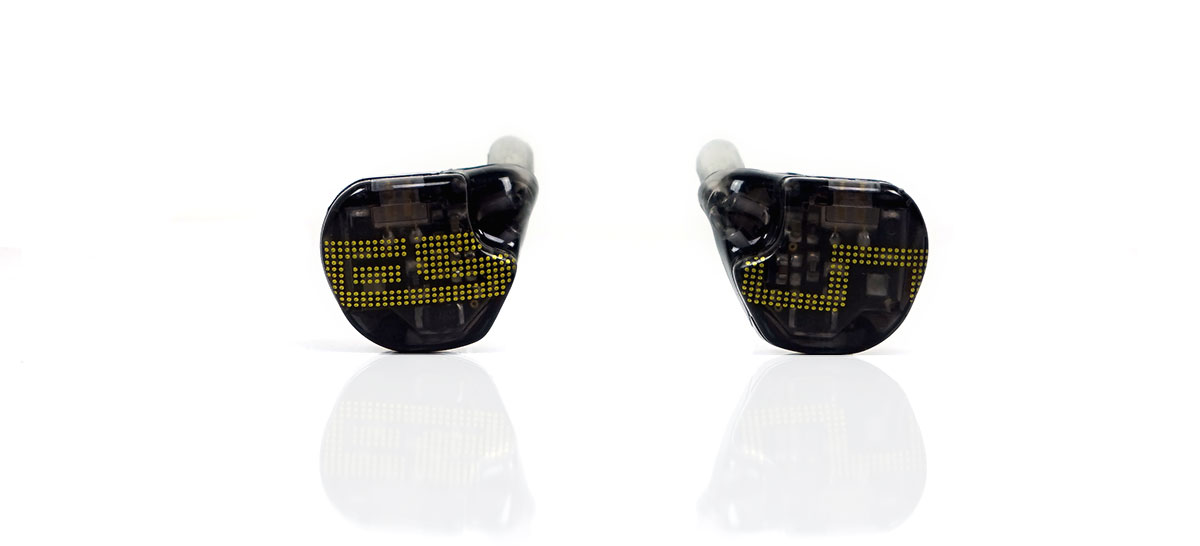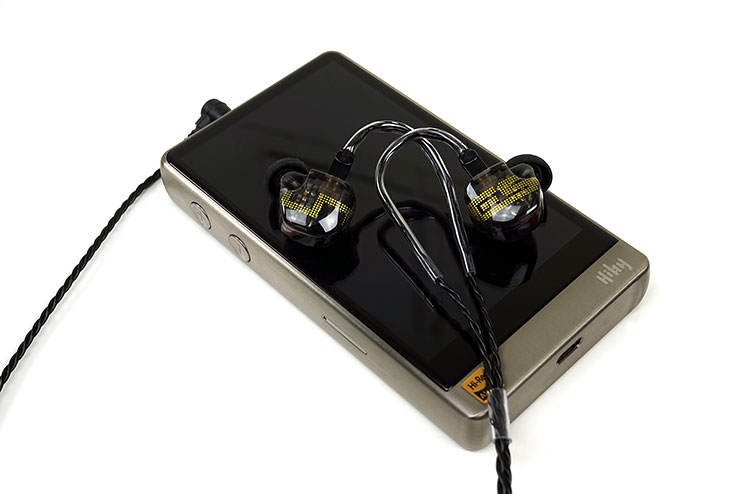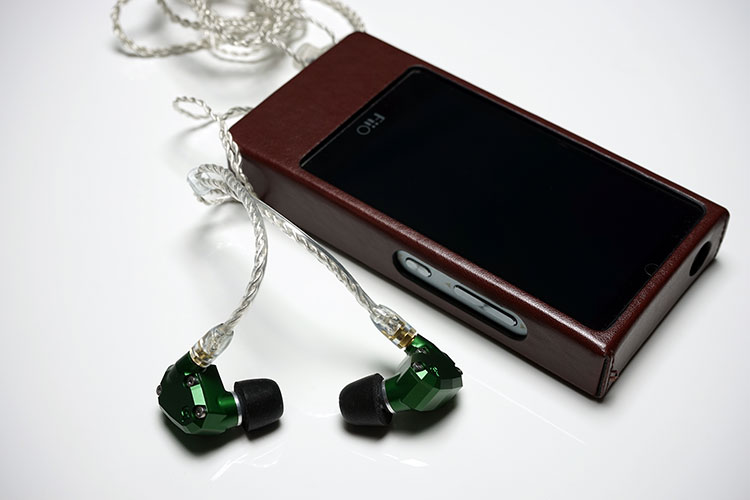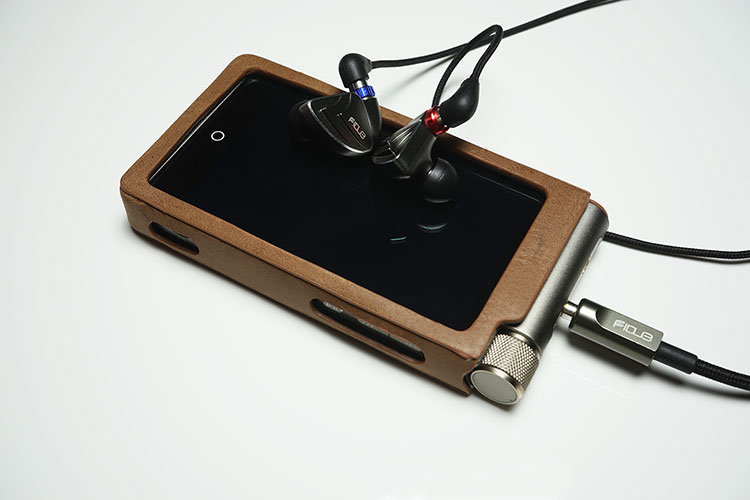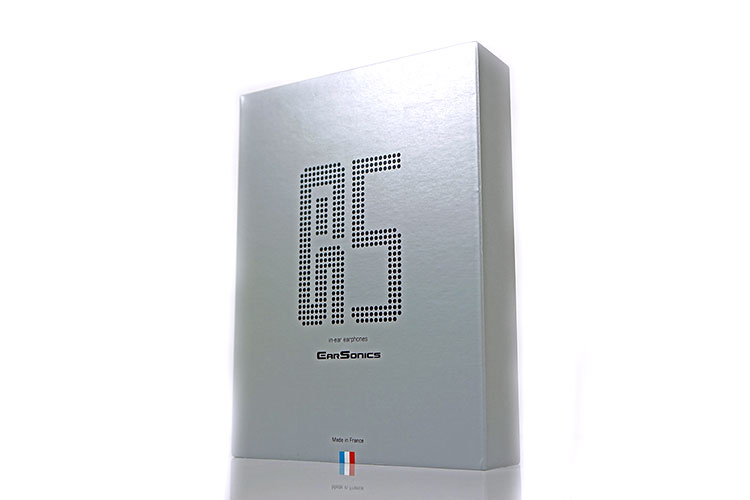Sound Impressions
Tonality & Presentation
The ES-5 is a lively and musical sounding V-shaped presentation with a clean and clear tonality. You will get a level of bass emphasis with a slightly dipped lower midrange so instrumental timbre is neutral to ever so slightly thin sounding. The majority of the ES-5 power will come from its low-end rumble and presence which is actually very pacy and impactful indeed.
From around 1-2k the ES-5 gets a little boost in energy which is sustained through the lower treble but not overly pushed. As such upper mids are clean and clear and vocals, particularly female vocals have a bit more presence compared to lower-mids but never strays into sibilant territory. It is not an overly relaxed top-end but then again it really needs to ‘pop’ to give some welcome contrast to the hefty bass response.
Staging on the ES-5 goes for height and depth over width with a slightly narrower and distant midrange response. That more neutral and cleaner instrumental timbre works to the ES-5’s advantage though delivering a fairly open sound with good separation.
Bass
The ES-5 has a sub-bass bias with a fairly linear drop to almost 1k with little or no mid-bass emphasis. As such you get plenty of rumble and decent power but not an overly warm sounding low-end response.
This is one of the better sub-bass signatures with excellent depth and presence as well as an above-average level of control. The pace of the low-end driver is spot on. It never lingers with a balanced level of decay to sound fairly natural yet never boomy or sluggish.
The lack of mid-bass presence will rob lower pitched instrumental timbre a little of some natural richness. Though they are clean and clear with excellent levels of detail they just lack a little body and sit further back in favor of vocals and percussion.
One thing to note is the source sensitivity from the ES-5. The ES-5 low-end tonal balance will change depending on the source with some delivering a much thicker low-end than others such as the R6 and others such as the DX200 sounding more linear.
Mids
Lower mids are behind a little from 500Hz-1-2k with a rise in energy beyond from 2-5k as they transition into the lower treble. The lack of mid-bass warmth and generally very linear drop will deliver a very neutral to slightly cool instrumental timbre with slightly less body as a result.
Clarity and control are good though so it will still sound relatively spacious with good separation. Generally, instrumental positioning especially lower-pitched guitar and string work will sit behind vocals, particularly higher-pitched female vocals which tend to benefit from the ES-5’s lift in energy.
That lift in energy thankfully avoids pushing so hard as to sound sharp or sibilant. The ES-5 does very well in that regard delivering a smooth attack and very little in terms of splashy upper-mid percussion passages.
Treble
Whilst it is forward sounding the ES-5 treble articulation and extension is very good indeed. It is also not so forward to sound overly peaky or harsh. It does lack a tiny bit of body but more than makes up for that with excellent sibilance control and detail.
You never get the feeling the ES-5 is lacking in air or rolled-off. Poor BA tuning often rolls off the top end to mask the technical limits of the drivers being used. Not so with the ES-5. This could easily have been a splashy strident signature but ends up being a bit more ethereal and precise in nature.
Matchability
Efficiency
The Earsonics ES-5 is rated at 33Ω and 117dB so it is fairly sensitive to voltage and volume control should be fairly easy to manage, even on weaker sources such as smartphones.
The ES-5 is not as efficient as the Campfire Audio Andromeda and some equivalent BA designs such as the 6-driver 64 Audio A6 so the volume is a toucher higher. That 33Ω rating puts a little higher than Noble Audio’s usual 30Ω standard so I would class the ES-5 as a medium efficiency IEM. Smartphones will sell it a bit short.
Dynamics and body get a little sucked out for my taste on the likes of the LG G6 making it sound too bright and brittle. The ES-5 seems to perform a little better on the ZTE Axon 7 with a bit more low-end impact. The top end on both is a bit splashy for my tastes though. Volume is one thing, scaling is another and the ES-5 can do better.
Noise
Background hiss and general noise control are excellent with the ES-5. Pretty much every source, DAP or portable amp paired with the ES-5 gave a solid black background and generally excellent dynamics once the power/OI was properly matched.
There is some minor channel imbalance on analog pots such as the iFi Nano iDSD BL and the ALO Audio V5 but nothing major and balances out pretty quickly once you start getting decent voltage levels.
Amping & Synergy
iBasso DX200 vs HiBy Music R6
Volume – DX200 90 – 100 volume in low gain AMP1 card unbalanced. R6 – low gain 50-60 unbalanced
The DX200 delivers slightly superior clarity and accuracy than the bassier and thicker sounding R6. However, that clarity on the AMP1 can leave the mids a bit lean with rock music where the lower range is called on to deliver power and rhythm. The fundamentals are not as authoritative using the ES-5 with the DX200 AMP1.
The R6, on the other hand, has a richer sounding lower midrange though a touch softer in comparison. The high OI should not be playing a significant role at 33Ω with the R6/ES-5 pairing but I cannot entirely discount it. Overall I would take the more rounded musicality of the R6/ES-5 over the more ‘correct sound’ of the DX200 AMP1 for anything mid-centric that requires significant lower mids performance.
For EDM and other similar genres, the synergy is less clear-cut. The lack of lower-mid bias in EDM takes away that slight weak spot with the DX200/ES-5 pairing so it largely depends if you like your bass thick and warm for EDM or more linear and accurate for the DX200. If you have AMP2 or AMP5 cards then the DX200 should have an edge with the ES-5 with its more musical slant and generally cleaner top end.
FiiO X7 Mark II
Volume: 50-65 in low gain unbalanced output
The X7 Mark II sat between the R6 and the DX200 AMP1 unbalanced outputs in terms of tonal balance with the ES-5. Again, the ES-5 worked well with the AM3a card with low noise and no background hiss. Volume requirements are higher than other 5 driver IEMs but nothing substantial with a wide range of 50-65 digital volume steps in low gain using the AM3a unbalanced output.
Tonally I got a cleaner presentation than the slightly warmer sound of the R6 though a more musical signature than the linear DX200 AMP1 card. The X7ii/ES-5 pairing had a nice kick in the low-end, clear mids, and a clean treble with a healthy level of sparkle. If anything the X7 Mark II plays to the strengths of the ES-5 with a dominant top and low-end presentation and sounds perfect with synth wave and EDM using the ES-5.
It will not give you the richness of the R6 lower-mids so it does not play as well for rock and metal. Its low-end is also a bit softer and not as full sounding as the R6/ES-5 combo. I would, however, prefer it to the DX200 AMP1 card which tends to sound just a bit too thin in the mids for my liking using the ES-5.
iFi Nano iDSD BL
Volume – 12 noon on IEMatch jack out, 10am on direct jack output (Foobar set at 75% volume)
The BL delivers a clean but smooth sound with excellent treble sparkle using the ES-5. You will get a 100% black background and zero noise using the IEMatch output. You will get attenuation but it is minor and easily rectified with a small volume adjustment.
There is a small lift in the sub-bass and mid-bass but with the IEMatch jack connection, I felt the ES-5 sounded far more balanced than the R6 pairing though not quite as accurate sounding as the DX200. You will get a bit more treble play with the ES-5/BL pairing and a slightly grainer sound but not a huge amount.
Chord Mojo
Volume control – Zero to red
The Mojo produced a fantastic match with the ES-5 and a more refined sound than the Nano iDSD BL. The ES-5’s low end sounds a bit more planted, tighter and more detailed but still impactful. The vocal presence and lower treble get a touch wetter and richer in timbre compared to the Nano iDSD BL, sibilance is less likely with this pairing. Treble has less grain with a more controlled delivery and better headroom using the ES-5.
Compared to the DAPs, the Mojo outmaneuvered the R6 in terms of top-end extension and a more accurate low-end and also sounded more powerful than the AMP1 card of the DX200.
Efficiency wise you do not need a huge amount of volume on the Mojo to drive the ES-5. In fact, if using it as a DAC out from a PC I advise using the PC for micro control rather than the Mojo. For Android and iOS, I would advise using the same USB volume control functions to adjust. You will not be able to get out of the red volume control region with the Mojo.
Select Comparisons
Campfire Audio Andromeda
$1099
Technical
The Andromeda is also a BA tuning and price-wise almost the same as the ES-5. It differs slightly in the top-end tubeless design but otherwise caters to similar audiences.
The Andromeda rated at 12.5Ω and 115dB and is much more efficient though than the ES-5 requiring less voltage and output power. As such high OI amps will skew the tonal bias a lot more than the ES-5 on DAPs such as the HiBy Music R6 and Shanling M2s and it will show up noise and background hiss far quicker.
On the flipside, weaker sources tend to play out a bit better on the Andromeda and their supplied Litz cable is a much higher quality than the one supplied with the ES-5. You should cable roll the ES-5, not so much with the Andromeda.
Sound
Tonally the Andromeda could be classed as musical sounding with its u-shaped presentation but it differs markedly from the ES-5’s cooler-sounding V-Shaped presentation.
Of particular difference are the warmer mid-bass and generally richer instrumental timbre of the Andromeda creating a smoother and sweeter sounding mid-range. Instrumental note body has a bit more body and a sweeter sound than the ES-5.
The ES-5 will hit lower and harder than the Andromeda, its sub-bass has more presence and rumble so it will also sound a little deeper and more holographic in terms of staging. Instrumental positioning will be further back with a hall like dimension.
Both have refined vocal deliveries that do a fantastic job of avoiding unnecessary sibilance though again Andromeda’s better body and more elevated vocal presence is the more engaging of the two.
Both do treble very well with excellent articulation and detail however they do have different tonal qualities to them. Again, it’s that body thing with the Andromeda delivering a little more compared to the ES-5 which goes for a more forward and energetic top-end signature and a bit more sparkle in the final octave.
64 Audio A6
$899 (universal)
Technical
The A/U 6 from 64 Audio is a 6-BA driver monitor rated at 22Ω at 115dB. You can get it in universal (U) or custom (A) design and comes with a fairly similar cable to the ES-5 though a slightly different finish.
The A6 is fairly efficient, much more so than the ES-5 which requires up to 20 steps more volume in low-gain unbalanced from the likes of the FiiO X7 Mark II. It will, however, be more sensitive to higher noise floors than the ES-5 so ‘hiss potential’ on the A6 is higher.
Sound
The A6 sounds quite different to the ES-5, more so with the stock cable which is just awful in terms of match-up. You really need to inject the A6 with some silver to get it going which makes the price of ownership that bit higher.
The A6 has a warmer sounding presentation than the ES-5 with decent sub-bass rumble, thickish but balanced mids and a relaxed treble response in stock format. By comparison, the ES-5 sounds a bit more nimble with a quicker paced but more powerful sub-bass response, a more linear and cooler sounding mid-bass, comparatively dipped but cleaner mids, and far better headroom.
I do like the texture and body of the A6’s mids, they suit a lot of rock numbers a bit better where you want a meatier guitar response but they can sound a little congested in comparison to the ES-5. Despite the ES-5 having dipped mids that leaner body delivers a bit more spacing and separation that works in its favor especially when combined with its livelier and airy top-end.
Fidue A91
$899
Technical
The Fidue A91 is a 5 driver but in a hybrid configuration with one dynamic driver and 4 balanced armatures. Rated at 13Ω and 113dB the A91 is more efficient and easier to drive than the ES-5 though less efficient than either the A6 or Andromeda.
Noise and background hiss control are better on the ES-5 than the A91. Though the A91 is pretty good in its own right it is marginally more susceptible to higher noise floors than the ES-5. Both scale well with good amping signals and can run quite happily from good DAPs and portable amps.
Sound
Both the A91 and ES-5 have excellent sub-bass depth and presence but with slightly different tonal qualities. The A91 is that of a dynamic driver so it is slightly slower with longer decay and a softer attack. It is not as tight and well defined but it delivers a bit more power, better texture and sounds the more natural of the two.
Both have a linear drop with not so much mid-bass warmth with the A91 the gentler of the mid to upper bass curves with less dipped lower mids. As a result, the instrumental timbre on the A91 is a bit thicker and more natural sounding than the ES-5’s more neutral timbre and lighter instrumental body. Instrumental positioning on the ES-5 is also a bit further back than the A91 creating a perceptibly bigger sounding staging quality.
Vocals on the A91 are a little further forward sounding with more body than the ES-5. Both though have excellent sibilant control and despite the lighter body, the ES-5 vocal delivery is not sharp or harsh sounding.
Treble on the ES-5 is more forward sounding, more energetic, and with better sparkle than the A91. The A91 is the more relaxed of the two at least in the lower treble response which is a bit more muted. The A91 upper treble performance is a bit better so you do get some nice sparkle but not quite as abundant as the ES-5 and it does fall away a little bit faster.
Our Verdict
The ES-5 is a confident musical sounding IEM. It is not for the analytical crowd though and its V-shaped energetic response wears its heart on a sleeve with regards to matchability. This is the type of IEM that works really well with EDM, large-scale orchestral works, and anything that needs excellent depth and height.
I am also pleased that despite the dipped mids it sounds clean and clear with good levels of instrumental separation. Vocals are sibilant-free and treble avoids being overly splashy and peaky. The only real caveat is that it lacks a little bit of mid-range body that can leave the signature sounding thin. That shouldn’t be too surprising given the linear drop from the sub-bass and dipped lower mids in contrast to the elevated sub-bass slam and energetic treble.
And, it is a looker and I mean the internals. Whilst the external shape remains largely unchanged from the excellent ES-3, the transparent shell offers a welcome peek into a delightfully organized internal design. This is OCD design at its best for me and should be set down as an example of how to organize the whole driver and wiring properly.
This is a very competitive price point these days with the Andromeda and the A91 to name but a few excellent IEMs coming in at a similar price point. However, I think the ES-5 delivers something a bit different and should offer another interesting option for people to consider for their hard-earned cash.
ES-5 Technical Specifications
- Sensibility: 117 dB/mW
- Frequency response: 10 Hz -20 kHz
- DCR: 33 ohms
- Driver: 5 drivers with 3 way HQ impedance corrector

